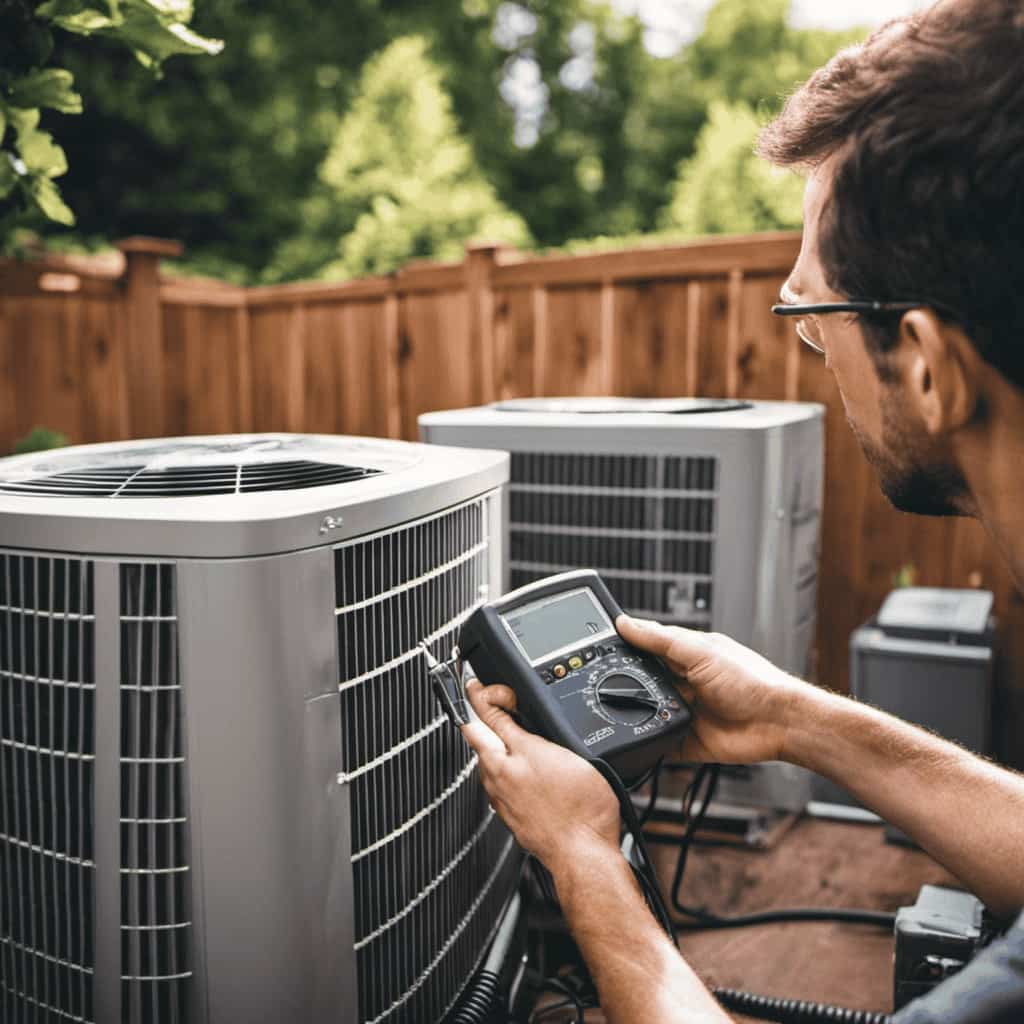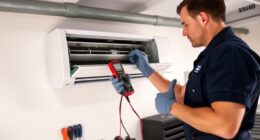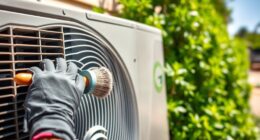Are you fed up with soaring energy costs? Don’t worry, we have the perfect solution for you! Check out our comprehensive guide on how to save energy using heat pumps.
From optimizing settings to utilizing renewable energy sources, we’ve got you covered. Say goodbye to wasted energy and hello to a more efficient home.
In this article, we’ll share the top energy-saving techniques for heat pumps. Get ready to save money, reduce your carbon footprint, and stay comfortable all year round.
Let’s dive in!

Key Takeaways
- Set the temperature at a reasonable level for comfort and efficiency.
- Schedule regular maintenance and cleaning to ensure efficient operation.
- Insulate and seal the home to reduce heat loss and maintain a comfortable indoor temperature.
- Utilize programmable thermostats to optimize energy usage and maintain comfort.
Optimizing Heat Pump Settings
Let’s start by optimizing our heat pump settings to maximize energy efficiency. Heat pump efficiency is directly influenced by how well it can control temperatures. To achieve optimal efficiency, it’s important to set the temperature at a reasonable level that still provides comfort. Setting the temperature too high or too low can put unnecessary strain on the heat pump, leading to increased energy consumption.
Additionally, it’s recommended to program temperature setbacks during times when the house is unoccupied or at night when lower temperatures are tolerable. This allows the heat pump to work less when it’s not needed, saving energy in the process.
By optimizing our heat pump settings, we can significantly improve its efficiency and reduce energy consumption.
Transitioning into the subsequent section about regular maintenance and cleaning, let’s explore how these practices can further enhance our heat pump’s efficiency.

Regular Maintenance and Cleaning
To ensure optimal energy efficiency, we regularly maintain and clean our heat pumps. Following a maintenance schedule is essential to keep the system running smoothly and prevent any potential issues. We recommend scheduling professional maintenance at least once a year.
During these visits, technicians will inspect and clean the components of the heat pump, including the filters, coils, and fans. Regular cleaning techniques involve removing dirt and debris from the outdoor unit and cleaning or replacing the filters as needed.
Additionally, it’s important to keep the surrounding area free from obstructions and vegetation.
By following these maintenance and cleaning techniques, you can ensure that your heat pump operates efficiently and effectively.

Now, let’s move on to the next section, which focuses on insulating and sealing the home.
Insulating and Sealing the Home
We can maximize energy efficiency by insulating and sealing our home properly. This step is crucial in reducing heat loss and maintaining a comfortable indoor temperature.
Here are two key methods that can greatly improve the energy efficiency of our homes:
-
Energy efficient windows: Investing in energy efficient windows can significantly reduce heat transfer and air leakage. These windows are designed with advanced insulation materials and multiple glazing layers, which help to keep the indoor temperature stable and prevent drafts.

-
Weather stripping: Properly sealing the gaps around doors and windows using weather stripping can prevent cold air from entering and warm air from escaping. This simple and cost-effective technique can significantly reduce energy loss and improve the overall energy efficiency of our home.
Utilizing Programmable Thermostats
Programmable thermostats offer an effective way to optimize energy usage and maintain a comfortable temperature in our homes. These smart devices come equipped with a range of features that allow us to create energy-efficient schedules tailored to our specific needs.
One of the key features is the ability to set different temperature settings throughout the day, ensuring that heating or cooling is only activated when necessary. By programming the thermostat to lower the temperature during times when we’re away or asleep, we can significantly reduce energy consumption without sacrificing comfort.
Additionally, some programmable thermostats can be controlled remotely through smartphone apps, allowing us to adjust settings even when we aren’t at home. This level of control and convenience further enhances our ability to save energy and reduce utility costs.

Supplementing With Renewable Energy Sources
By using renewable energy sources in conjunction with our heat pumps, we can both reduce our carbon footprint and lower our energy bills. There are two primary ways to supplement heat pumps with renewable energy sources: solar panels and geothermal systems.
Solar panels: Installing solar panels on our homes allows us to harness the power of the sun to generate electricity. This renewable energy source can be used to power our heat pumps, reducing our reliance on traditional electricity sources and saving us money on our energy bills. Additionally, solar panels have a long lifespan and require minimal maintenance, making them a cost-effective and sustainable energy solution.
Geothermal systems: Geothermal systems utilize the stable temperature underground to heat and cool our homes. By tapping into the earth’s natural heat, we can significantly reduce our energy consumption and carbon emissions. Geothermal systems work by circulating a fluid through underground pipes, absorbing heat in the winter and releasing it in the summer. This renewable energy source is highly efficient, reliable, and environmentally friendly.
Frequently Asked Questions
How Do Heat Pumps Compare to Traditional Heating Systems in Terms of Energy Efficiency?
Heat pumps are more energy efficient compared to traditional heating systems. They use electricity to transfer heat from the outside to inside, rather than generating heat directly. This results in significant energy savings.

Are There Any Specific Temperature Settings That Are Recommended for Optimizing the Performance of a Heat Pump?
Optimal temperature settings can greatly enhance the performance of a heat pump. By setting the thermostat to a comfortable yet energy-efficient temperature, we can reduce energy consumption and save money on heating bills.
What Are Some Common Signs That Indicate a Heat Pump May Need Maintenance or Repair?
Signs that indicate a heat pump may need maintenance or repair include inadequate heating or cooling, increased energy bills, strange noises, and reduced airflow. Regular maintenance is essential to ensure optimal performance and prevent costly repairs.
Can Heat Pumps Be Used in Colder Climates, Where Temperatures Regularly Drop Below Freezing?
Yes, heat pumps can be used in colder climates where temperatures regularly drop below freezing. While heat pump efficiency may decrease in extreme cold, they can still provide sufficient heat in subzero temperatures.
Are There Any Government Incentives or Rebates Available for Installing Energy-Efficient Heat Pumps in Homes?
Yes, there are government incentives and rebates available for installing energy-efficient heat pumps in homes. These incentives and rebates aim to encourage heat pump installation and help homeowners save on energy costs.

Conclusion
In conclusion, by implementing these top energy-saving techniques for heat pumps, we can harness the power of euphemism to create a delightful symphony of efficiency.
Optimizing settings, regular maintenance, insulating and sealing our homes, utilizing programmable thermostats, and supplementing with renewable energy sources won’t only save us money, but also transform our heat pumps into graceful ballet dancers, pirouetting through the seasons with precision and grace.
Let’s embark on this energy-saving journey and embrace the beauty of sustainability.









